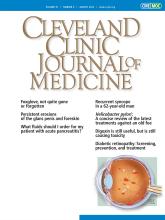
I have a true affection for the phenomenon of coincidence, so the timing of the submission of the Durán Crane et al1 paper on the use and toxicity of digoxin in this issue of the Journal got my attention.
A somewhat fragile nonagenarian patient was struggling with her intermittently rapid atrial fibrillation. Although her baseline ejection fraction was normal, when her rate went up, she became dyspneic. She was intolerant to multiple medications prescribed for rate and rhythm control, including fatigue from beta-blockade, and at times she had low blood pressure with orthostatic symptoms (independent of her ventricular rate). There was an initial desire to avoid ablation, and in my discussion with her out-of-state cardiologist, I questioned whether there might be value in low-dose digoxin for symptom control. I think that he assumed I was calling from a rotary telephone. Ultimately, the patient developed an 8-second sinus pause, got a pacemaker and an ablation, and has done well on far fewer medications, not needing medications for rate control. But I nonetheless decided to explore the recent digoxin literature. I wanted to see where the drug that was popularized in 1785 by the English botanist and physician William Withering2 and that had been a mainstay of cardiac treatment for many decades, including during my early medical career, had landed. That’s when the paper by Durán Crane et al1 was submitted—nice coincidence.
Granted that I now practice within a very specialized cardiovascular medicine community, but I couldn’t recall the last patient I’d seen with digoxin on their list of medications. Nonetheless, it remains in clinical use. Digoxin has unique, if still not completely understood, pharmacodynamic effects. It has positive inotropic effects on cardiac myocytes, presumably due to increased intracellular calcium. It was initially used in treating “dropsy” (congestive heart failure), with subsequent documentation of its beneficial effect on ventricular function. It has vagomimetic effects that can slow the ventricular response in atrial fibrillation; these effects seem to require cardiac innervation, as they may not occur in transplanted hearts.3 At higher serum levels, digoxin can increase myocyte automaticity and may increase the atrioventricular nodal refractory period. This combination accounts for some of the cardiac toxicity associated with its use, including the “classic” accelerated junctional tachycardia with conduction block. There is a narrow therapeutic window between efficacy and toxicity, with a lot of individual patient variability. Thus, it is not really surprising that use of the drug has waned dramatically over the past decades. Its use in treating patients with heart failure and atrial fibrillation has been supplanted by multiple medications, yet it still has a lower-tier place in the formal guidelines for the management of atrial fibrillation and heart failure.1
Back in the time of rotary telephones, when using digoxin for rate control in atrial fibrillation we dosed it by following the heart rate. We pushed it intravenously and expected a fairly rapid response over the course of hours as we fully “loaded” the patient. When treating patients with heart failure, we generally dosed digoxin paying attention to the patient’s weight, kidney function, and concomitant medications. We were astute in asking about gastrointestinal symptoms and visual aberrations with chronic therapy, but there was little reliance on drug levels. And, as discussed in detail by Gona et al,4 not routinely using drug levels to monitor for toxicity has likely been to patients’ detriment and has appropriately contributed to the decreased use of digoxin. Do questions remain as to whether it still has a place at the therapeutic table?
The use of digoxin for treatment of heart failure went out of fashion quickly after studies indicated a lack of effect on improving mortality and drugs with a marked positive effect on mortality became available. The landmark Digitalis Investigation Group study5 in 1997 showed that patients with heart failure and reduced ejection fraction who received digoxin along with a diuretic and angiotensin-converting enzyme inhibitor had no reduction in overall mortality; however, digoxin reduced hospitalizations and death attributable to heart failure. Toxicity possibly attributable to digoxin was slightly increased in the digoxin-treated group compared with the placebo group. A number of studies have followed this, yielding mixed results, but with reduced digoxin toxicity when drug levels were monitored. As an indication that use of the drug for treating heart failure remains an open issue, a perusal of the clinical trial registration site ClinicalTrials.gov shows an active study on the effect of digoxin on heart failure.6
The value of digoxin in rate control in patients with “permanent” atrial fibrillation also remains an open question. Although rate control, as opposed to rhythm normalization, may not be the ideal approach for many with atrial fibrillation, digoxin for a select few may be a very reasonable option. Digoxin may not be as good as beta-blockade for rate management during exercise, but several studies have indicated that it may nonetheless improve patients’ sense of exercise tolerance and well-being. This topic is nicely summarized in an editorial by Dorian and Angaran.7
So perhaps what Withering wrote about digoxin in 1776 is still correct: “It is certainly a very active medicine, and merits more attention than modern medicine bestows upon it.”7,8 We need to acknowledge its potential toxicity and utilize our clinical laboratory to minimize it. We are now fortunate to have a growing list of very effective treatment options for our patients with heart failure and atrial fibrillation, but digoxin may indeed still be a useful option for some patients.1
- Copyright © 2024 The Cleveland Clinic Foundation. All Rights Reserved.






